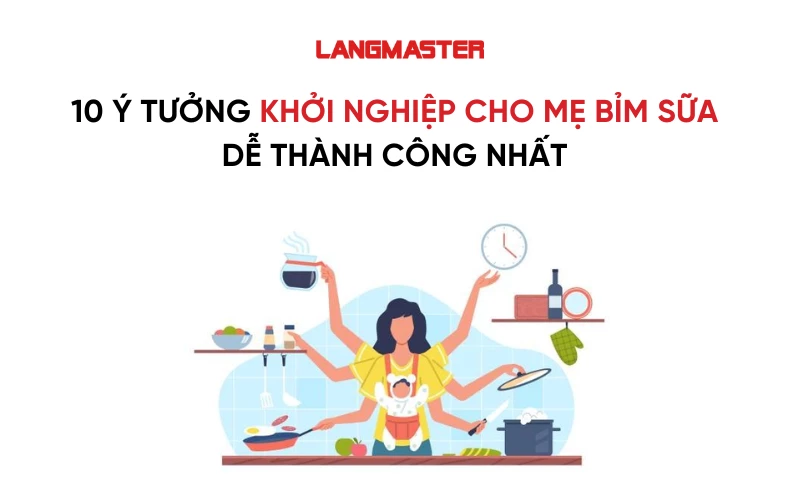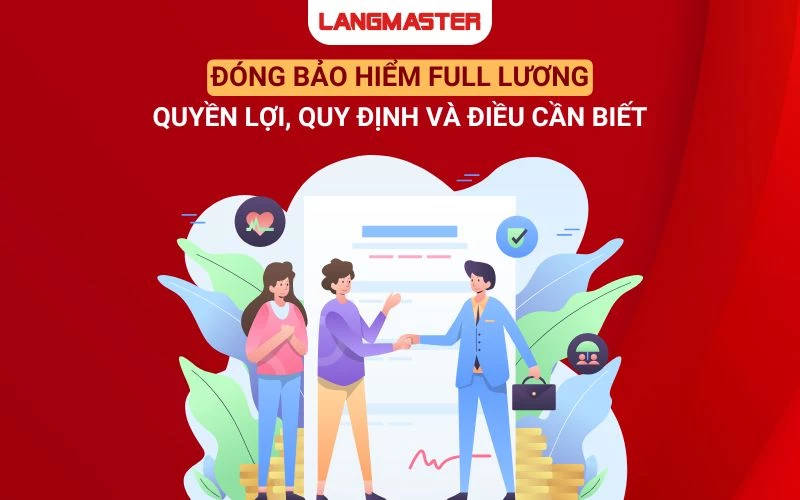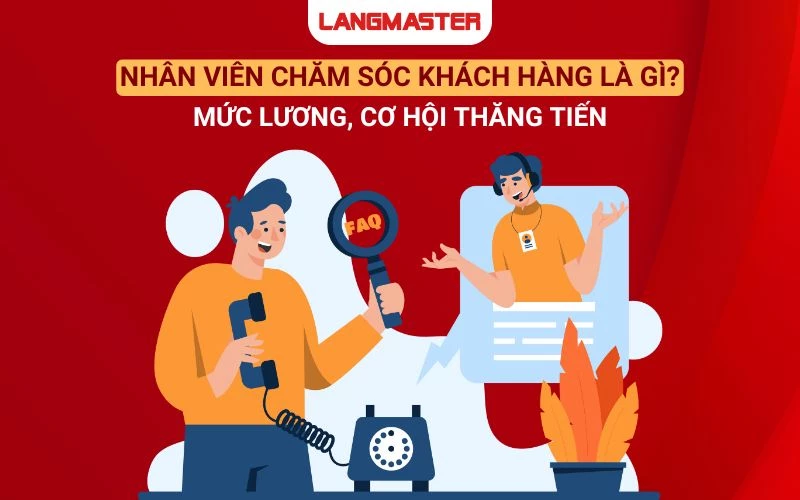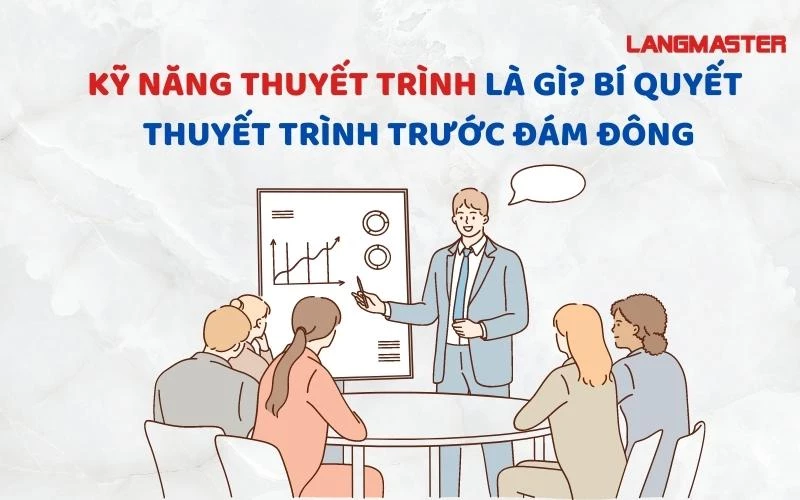Bạn sắp có bài thuyết trình tiếng Anh ở lớp, ở công ty nhưng không biết truyền tải, thuyết trình như thế nào cho ấn tượng, chuyên nghiệp? Hãy cùng Langmaster khám phá cách thuyết trình bằng tiếng Anh và các mẫu câu thuyết trình tiếng Anh thường gặp để bạn tham khảo.
1. Chi tiết các mẫu câu thuyết trình tiếng Anh thường gặp
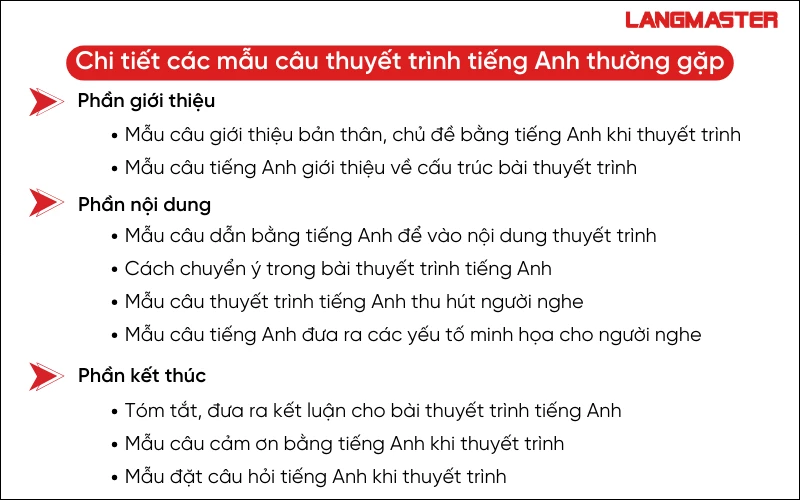
1.1 Phần giới thiệu
1.1.1 Mẫu câu giới thiệu bản thân, chủ đề bằng tiếng Anh khi thuyết trình
Dưới đây là các mẫu câu giới thiệu bản thân bằng tiếng Anh khi thuyết trình để bạn tham khảo:
- Good [morning/afternoon/evening], ladies and gentlemen. My name is [Your Name], and I am pleased to be here today for [purpose of presentation].
- Hello everyone, my name is [Your Name]. I'm excited to have the opportunity to speak with you today about [topic].
- Hi, everyone. I’m Marc Hayward. Good to see you all.
- Let me introduce myself; my name is…, member of group …
- Hey everyone, I'm [Your Name]. Today, I'm going to talk about [topic].
- Greetings, my name is [Your Name]. With [number] years of experience in [field], I'm here to discuss [topic] with you.
- Good [morning/afternoon/evening] everyone! My name is [Your Name], and before we dive into [topic], let's take a moment to get to know each other. Could each of you briefly introduce yourselves?
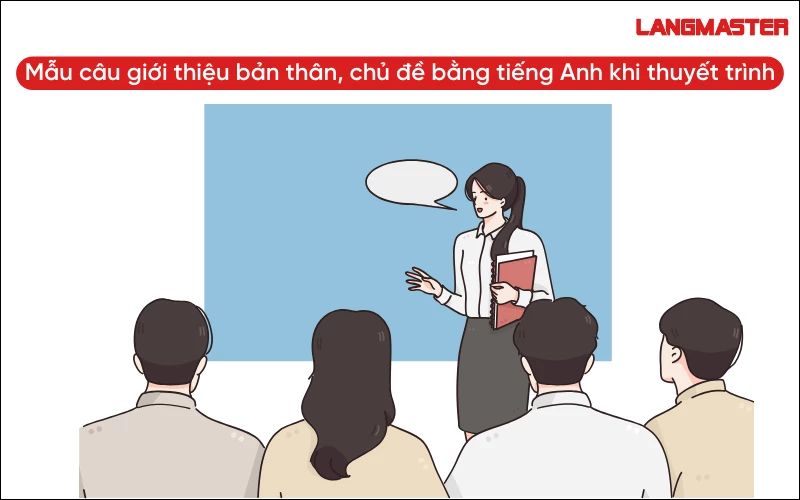
Mẫu câu giới thiệu bản thân, chủ đề bằng tiếng Anh khi thuyết trình
1.1.2 Mẫu câu tiếng Anh giới thiệu về cấu trúc bài thuyết trình
Dưới đây là các mẫu câu giới thiệu về cấu trúc bài thuyết trình bằng tiếng Anh để bạn tham khảo:
- My talk will be in three parts. First, I’ll delve into the background of our topic. Then, I'll discuss current trends, and finally, I'll propose some solutions.
- I’ve divided my presentation into three parts. In the first part, I’ll introduce the problem. Then in the second part, I'll analyze its impact. Finally, I’ll suggest possible strategies for improvement.
- In the first part of my presentation, I’ll provide an overview of the historical context. Then in the second part, I’ll examine the challenges we face today. Finally, I’ll propose strategies for moving forward.
- My presentation is divided into three parts. Firstly, I will talk about the importance of our topic. Then I will look at current research findings. Next, I’ll discuss potential applications in real-world scenarios.
- I’ll start with an introduction to our topic, highlighting its significance. Then I will move on to explore different perspectives. Finally, I’ll conclude with recommendations for future action.
- Firstly, I will talk about the theoretical framework. Then I will present our methodology and findings. Finally, I’ll discuss the implications of our research."
- I’ll begin with a brief overview of the problem. Then I will discuss existing solutions. Next, I’ll propose innovative approaches. Finally, I’ll conclude with a call to action.
- Firstly, I will provide some background information. Then I’ll delve into the main challenges we face. Finally, I’ll outline potential strategies for addressing these challenges.
- My presentation consists of three parts. Firstly, I’ll introduce the concept. Then I’ll discuss its applications in various contexts. Finally, I’ll explore future possibilities.
- I’ll start with an overview of the current situation. Then I will discuss recent developments. Finally, I’ll offer recommendations for future actions.
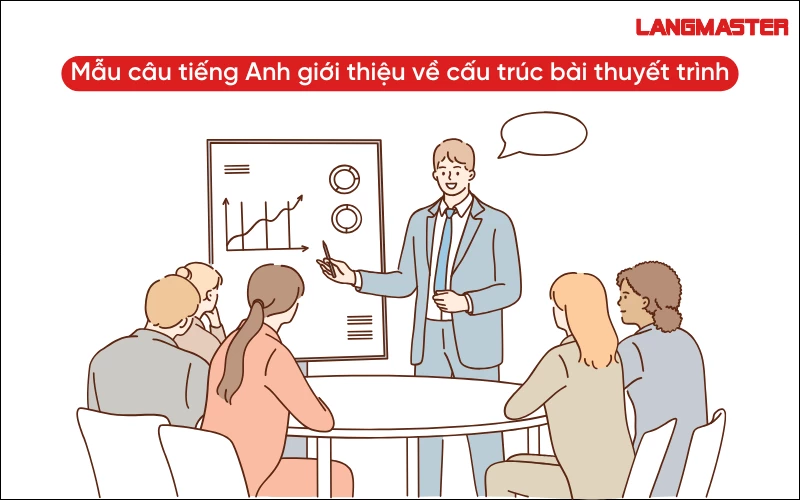
Mẫu câu tiếng Anh giới thiệu về cấu trúc bài thuyết trình
1.2 Phần nội dung
1.2.1 Mẫu câu dẫn bằng tiếng Anh để vào nội dung thuyết trình
Dưới đây là các mẫu câu dẫn bằng tiếng Anh để vào nội dung thuyết trình mà bạn có thể tham khảo:
- I’ll start with some general information about our topic to provide context for our discussion.
- I’d just like to give you some background information about the issue we'll be addressing today.
- As you remember, we are concerned with finding solutions to the challenges in our industry.
- As you are all aware, sustainability has become a key focus in our company's operations.
- As you all know, the education system has undergone significant changes in recent years.
- Let's begin by revisiting the goals we set at the beginning of this project.
- Before we delve into the specifics, I'd like to refresh your memory on the objectives of our research.
- Before we proceed, let me provide a brief overview of the historical context of our topic.
- Let's take a moment to recall the importance of this issue in our daily lives.
- Before diving into the details, it's important to understand the broader implications of our findings.
1.2.2 Cách chuyển ý trong bài thuyết trình tiếng Anh
Dưới đây là các mẫu câu giúp chuyển ý trong thuyết trình tiếng Anh để bạn tham khảo:
- So, first…
- So now we come to the next point, which is…
- Let’s turn to the next issue…
- Now let’s move to the first part of my talk which is about [topic]. So, first, let's delve into the background of this issue.
- To begin with, let's explore the various factors contributing to [topic].
- This leads me to my next point, where we'll examine the implications of [topic] on our society.
- That completes our discussion on [topic]. Now, let's transition to the next part of our presentation.
- That’s all I want to say about [topic]. Now, let's shift our focus to [next topic].
- Ok, I’ve explained how [topic] impacts [aspect]. Now, let's explore the strategies for addressing this issue.
- So now we come to the next point, which is [next topic]. Let's delve into the details.
Xem thêm: CÁC CÁCH THUYẾT TRÌNH HAY, ẤN TƯỢNG KHÔNG THỂ BỎ QUA
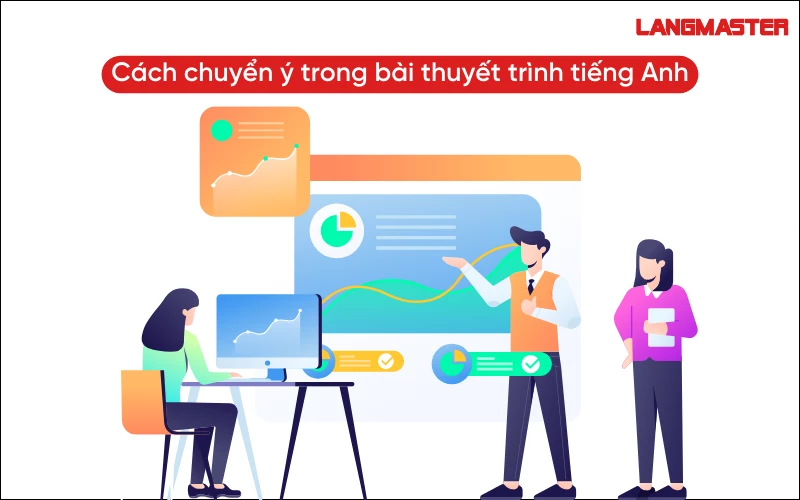
Cách chuyển ý trong bài thuyết trình tiếng Anh
1.2.3 Mẫu câu thuyết trình tiếng Anh thu hút người nghe
Dưới đây là các mẫu câu thuyết trình tiếng Anh thu hút người nghe để bạn có thể tham khảo:
- I’m going to let you in on a secret… Did you know that [interesting fact related to your topic]?
- You may already know this, but just in case you don’t… [briefly introduce a surprising or lesser-known aspect of your topic].
- Because time is tight, you may want to consider [action or solution] as it can save you valuable time and resources.
- Here’s what’s most important about this for you: [highlight the key takeaway or benefit for your audience].
- Why you need to know about [topic] is because [explain the significance or relevance of the topic to your audience].
- If you’re only going to remember one thing from today's presentation, it should be [emphasize the most crucial point or takeaway].
- If you’re only going to do one thing after leaving this presentation, it should be [suggest a specific action or strategy for your audience to take].
1.2.4 Mẫu câu tiếng Anh đưa ra các yếu tố minh họa cho người nghe
Dưới đây là các mẫu câu tiếng Anh đưa ra các yếu tố minh họa cho người nghe để bạn tham khảo:
- This graph shows you the correlation between [variable A] and [variable B], highlighting the impact of [factor X].
- Take a look at this visual representation, which provides insights into the relationship between [factor Y] and [outcome Z].
- If you look at this, you will see a clear trend emerging, indicating the influence of [variable C] on [result D].
- I’d like you to look at this chart, which demonstrates the fluctuations in [parameter E] over time.
- This chart illustrates the figures regarding [topic], allowing us to grasp the magnitude of [issue F].
- This graph gives you a breakdown of the distribution of [data point G] across different regions.
- As you can see from this visual aid, there is a noticeable pattern in the relationship between [variable H] and [outcome I].
- This clearly shows the impact of [factor J] on [result K], providing valuable insights into the dynamics of the situation.
- From this, we can understand how [factor L] influences [aspect M], shedding light on the underlying mechanisms at play.
- This area of the chart is interesting as it highlights the outlier data points, prompting further investigation into [phenomenon N].
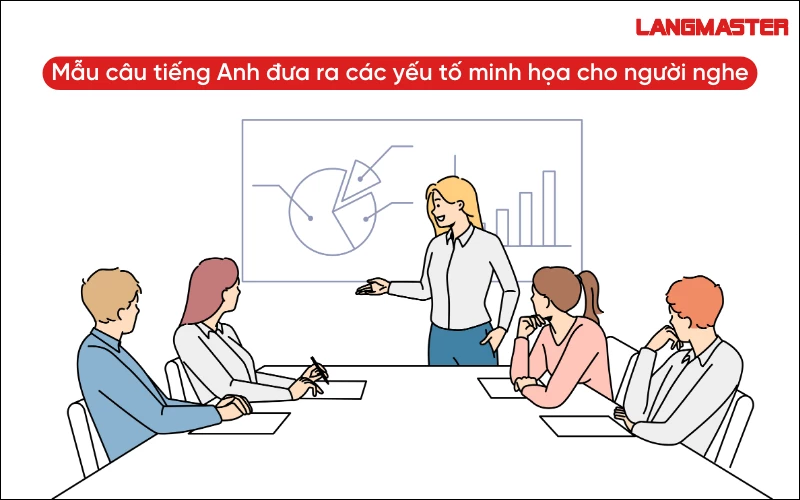
Mẫu câu tiếng Anh đưa ra các yếu tố minh họa cho người nghe
1.3 Phần kết thúc
1.3.1 Tóm tắt, đưa ra kết luận cho bài thuyết trình tiếng Anh
Dưới đây là các mẫu câu tóm tắt, đưa ra kết luận cho bài thuyết trình tiếng Anh để bạn tham khảo:
- Okay, that ends the third part of my talk. Now let’s move on to summarizing the key points.
- That’s all I want to say about [topic]. Now, let's wrap up by highlighting the main takeaways.
- To sum up, we've discussed the importance of [topic] and explored various strategies for addressing it.
- I’d like to end by emphasizing the main points we've covered today, underscoring their significance.
- I’d like to end with a summary of the main points to ensure clarity and reinforce understanding.
- Well, I’ve covered the points that I needed to present today. Now, let's recap and draw some conclusions.
- In conclusion, we've examined the key aspects of [topic] and their implications. Now, let's reflect on what we've learned.
- To conclude, I'd like to reiterate the significance of [topic] and its relevance in today's context. Let's summarize our key findings.
- That brings us to the end of our presentation. Before we finish, let's summarize the main points one last time for clarity.
- In summary, we've explored the challenges and opportunities related to [topic]. Now, let's distill our discussion into actionable insights.
- And with that, we've reached the end of our discussion. Let's conclude by summarizing the key takeaways and considering their implications.
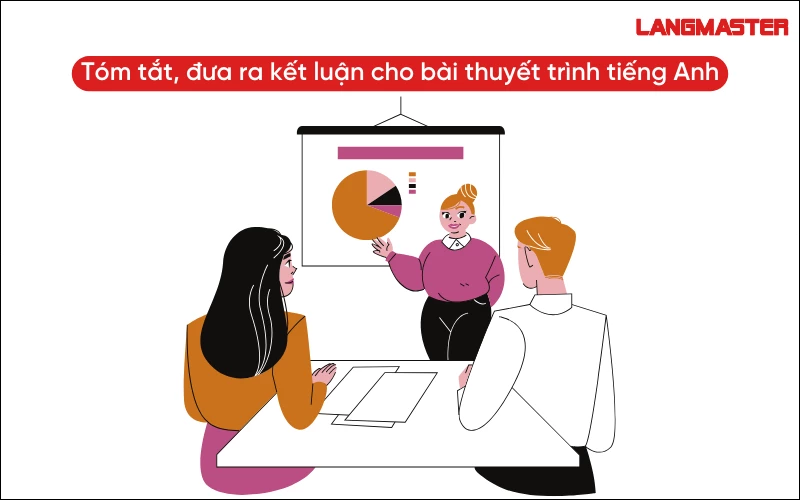
Tóm tắt, đưa ra kết luận cho bài thuyết trình tiếng Anh
1.3.2 Mẫu câu cảm ơn bằng tiếng Anh khi thuyết trình
Dưới đây là các mẫu câu cảm ơn bằng tiếng Anh khi thuyết trình để bạn có thể tham khảo:
- I’d like to thank you for taking time out to listen to my presentation. Your attention is truly appreciated.
- Thank you for listening and for your attention throughout the presentation. It means a lot.
- Many thanks for coming today and for your active participation. Your presence made a difference.
- Thank you for listening and for your attention to the key points discussed. It's been a pleasure presenting to you.
- Thank you all for listening. It was a pleasure being here today and sharing my insights with you.
- Well, that’s it from me. Thanks very much for your attentive listening and engagement.
- Many thanks for your attention and for being such an engaged audience. It's been a rewarding experience.
- May I thank you all for being such an attentive audience? Your interest and focus are greatly appreciated.
- Thank you sincerely for your attentive presence and for lending me your ears during the presentation.
- Thank you for your attention and for being such an interactive audience. Your engagement made the presentation more enjoyable.
1.3.3 Mẫu đặt câu hỏi tiếng Anh khi thuyết trình
Dưới đây là mẫu đặt câu hỏi tiếng Anh khi thuyết trình để bạn tham khảo:
- Now we have half an hour for questions and discussion. I encourage you to share your thoughts and questions.
- So, now I’d be very interested to hear your comments. Please feel free to share any insights or reflections you may have.
- And now if there are any questions, I would be pleased to answer them. Don't hesitate to raise your hand or speak up.
- At this point, I invite you to engage in an open dialogue. Your questions and input are highly valued.
- Now is the perfect time for interaction. I'm eager to hear your perspectives and address any queries you may have.
- We have some time for Q&A. I invite you to take this opportunity to ask any questions or seek clarification.
- This is your chance to participate. I welcome any questions, comments, or suggestions you may have.
- The floor is open for discussion. I invite you to share your insights or raise any concerns you may have.
- Let's open the floor for questions and discussion. Your active participation will enrich our conversation.
- I'm here to facilitate a meaningful exchange. Please don't hesitate to engage with any questions or contributions.
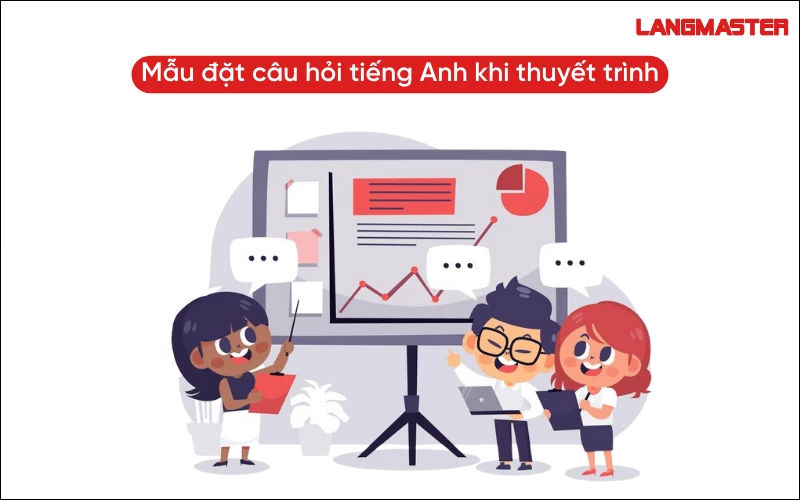
Mẫu đặt câu hỏi tiếng Anh khi thuyết trình
2. Cách thuyết trình bằng tiếng Anh ấn tượng, chuyên nghiệp
2.1 Chuẩn bị kỹ lưỡng nội dung trước khi thuyết trình
Để có một buổi thuyết trình diễn ra tốt nhất thì bạn cần chuẩn bị thật kỹ lưỡng, bao gồm về nội dung, tâm lý, cách diễn đạt. Khi đó, bạn có thể tự tin, thoải mái trình bày bài thuyết trình của mình, đồng thời kiểm soát được những gì bạn trình bày trước mọi người.
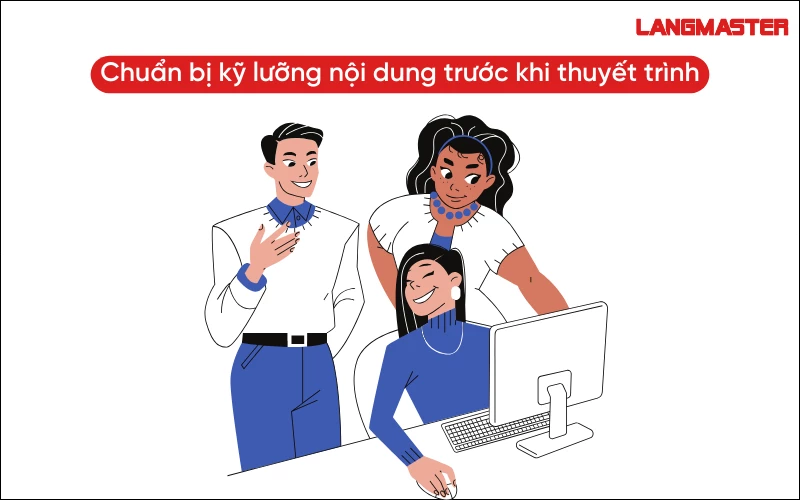
Chuẩn bị kỹ lưỡng nội dung trước khi thuyết trình
2.2 Xây dựng cấu trúc bài thuyết trình tiếng Anh rõ ràng
Để xây dựng một bài thuyết trình tiếng Anh rõ ràng và ấn tượng, bạn cần xây dựng cấu trúc bài thuyết trình rõ ràng với các phần mở bài, thân bài và kết bài. Điều này sẽ giúp cho bài thuyết trình của bạn được logic, dễ hiểu và để lại ấn tượng với người nghe hơn.
Ngoài ra, bên cạnh nội dung chính thì bạn đừng quên thêm các ví dụ minh họa cụ thể để làm cho nội dung thuyết trình được sống động, thuyết phục hơn.
2.3 Luyện tập thuyết trình lại nhiều lần
Cách thuyết trình bằng tiếng Anh ấn tượng nhất chính là bạn cần luyện tập lại nhiều lần. Bằng cách này, bạn có thể kiểm soát được tâm lý, cách diễn đạt và tự tin hơn khi thuyết trình. Đồng thời, điều này cũng giúp bạn làm quen với việc sử dụng tiếng Anh một cách tự nhiên, tăng khả năng phản ứng linh hoạt trong khi thuyết trình.
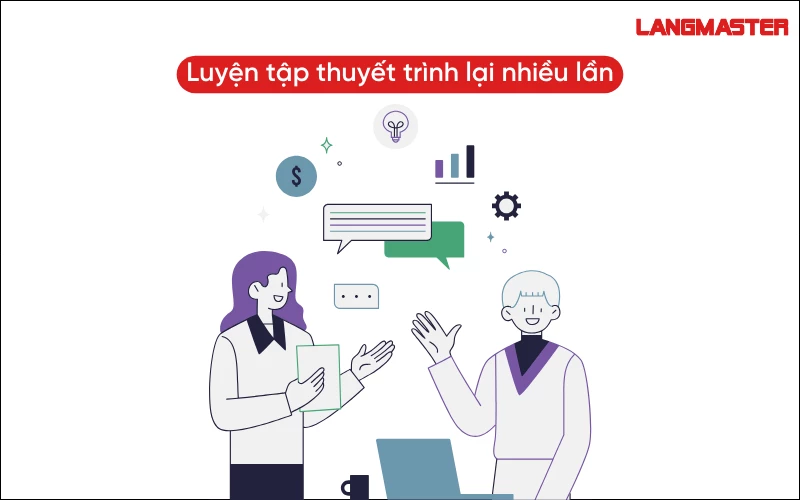
Luyện tập thuyết trình lại nhiều lần
2.4 Tương tác với người nghe
Một tips nhỏ nhưng lại vô cùng quan trọng khi bạn thuyết trình tiếng Anh chính là giữ tương tác với người nghe, đừng để buổi thuyết trình chỉ là sự trao đổi 1 chiều. Vì thế, hãy thường xuyên đặt câu hỏi giải trí nhằm tăng sự tương tác, thoải mái và còn tạo ấn tượng với người nghe.
2.5 Sử dụng ngôn ngữ cơ thể
Khi thuyết trình bằng tiếng Anh thì ngôn ngữ cơ thể cũng rất quan trọng, nó sẽ góp phần tạo nội dung, thể hiện sự tự tin và gây ấn tượng với người nghe. Vì thế, đừng quên chú ý đến quần áo, cử chỉ tay, dáng đứng, đi lại,...
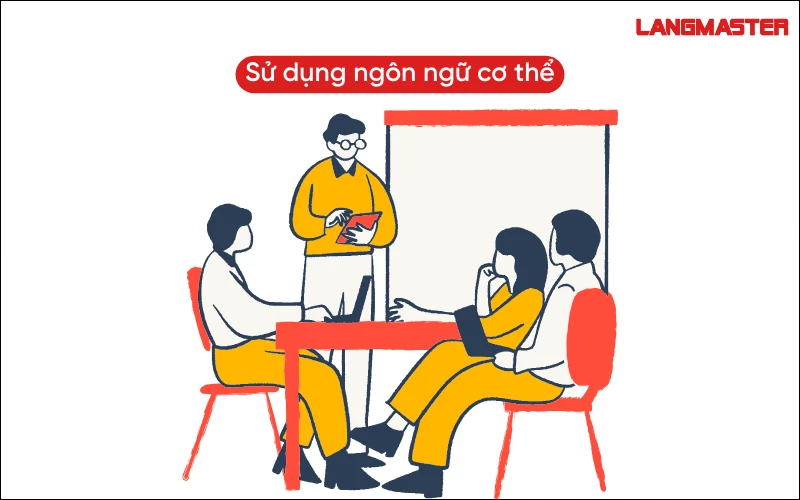
Sử dụng ngôn ngữ cơ thể
2.6 Sử dụng giọng văn cuốn hút, chuyên nghiệp
Để cho bài thuyết trình của bạn được ấn tượng, cuốn hút hơn thì hãy sử dụng giọng nói cuốn hút, nhấn nhá và các cụm từ quan trọng trong câu.
Xem thêm: KỸ NĂNG THUYẾT TRÌNH LÀ GÌ? BÍ QUYẾT THUYẾT TRÌNH HIỆU QUẢ
3. Gợi ý các bài thuyết trình bằng tiếng Anh hay theo chủ đề
Mẫu 1: Ô nhiễm môi trường
In today's era, environmental pollution has become a pressing concern for society. Environmental pollution refers to the presence of harmful substances and contaminants in the environment, causing negative impacts on both nature and human life. It affects land, water, and air, posing serious threats to human livelihoods.
Due to industrialization and global modernization, environmental pollution has exacerbated. It greatly affects the quality of life for all living beings, including humans, animals, and plants. Dangerous consequences arise from environmental pollution, directly impacting the normal functioning of ecosystems.
The current situation of environmental pollution is widely reported in the media, with images of overflowing waste and alarming statistics. Many days, the air quality in cities like Hanoi exceeds dangerous levels. Such severe pollution not only threatens human life but also significantly affects natural ecosystems, exacerbating global issues like the greenhouse effect and melting ice caps.
The primary cause of this pollution is the lack of awareness and inadequate measures to protect the environment. To mitigate pollution, various strategies such as tree planting, reducing non-renewable resource consumption, and proper waste management must be implemented. Protecting the environment from pollution is the responsibility of every individual and organization.
Therefore, it is crucial for everyone to understand the harmful effects of environmental pollution and take proactive steps to minimize waste and emissions. Only by doing so can we safeguard the Earth, human life, and the development of both society and nature.
Dịch:
Trong thời đại ngày nay, ô nhiễm môi trường đã trở thành mối lo ngại cấp bách của xã hội. Ô nhiễm môi trường là sự hiện diện của các chất có hại và các chất gây ô nhiễm trong môi trường, gây ra những tác động tiêu cực đến cả thiên nhiên và đời sống con người. Nó ảnh hưởng đến đất, nước và không khí, gây ra những mối đe dọa nghiêm trọng đối với sinh kế của con người.
Do quá trình công nghiệp hóa và hiện đại hóa toàn cầu, tình trạng ô nhiễm môi trường ngày càng trầm trọng. Nó ảnh hưởng lớn đến chất lượng cuộc sống của mọi sinh vật, bao gồm cả con người, động vật và thực vật. Hậu quả nguy hiểm phát sinh từ ô nhiễm môi trường, ảnh hưởng trực tiếp đến hoạt động bình thường của hệ sinh thái.
Thực trạng ô nhiễm môi trường hiện nay được đưa tin rộng rãi trên các phương tiện truyền thông, với hình ảnh rác thải tràn lan cùng những con số thống kê đáng báo động. Nhiều ngày, chất lượng không khí ở các thành phố như Hà Nội vượt ngưỡng nguy hiểm. Tình trạng ô nhiễm nghiêm trọng như vậy không chỉ đe dọa cuộc sống con người mà còn ảnh hưởng đáng kể đến hệ sinh thái tự nhiên, làm trầm trọng thêm các vấn đề toàn cầu như hiệu ứng nhà kính và băng tan.
Nguyên nhân cơ bản dẫn đến tình trạng ô nhiễm này là do thiếu nhận thức và chưa có biện pháp bảo vệ môi trường chưa đầy đủ. Để giảm thiểu ô nhiễm, phải thực hiện nhiều chiến lược khác nhau như trồng cây, giảm tiêu thụ tài nguyên không tái tạo và quản lý chất thải phù hợp. Bảo vệ môi trường khỏi ô nhiễm là trách nhiệm của mỗi cá nhân, tổ chức.
Vì vậy, điều quan trọng là mọi người phải hiểu được tác hại của ô nhiễm môi trường và thực hiện các bước chủ động để giảm thiểu chất thải và khí thải. Chỉ bằng cách đó chúng ta mới có thể bảo vệ Trái đất, sự sống con người và sự phát triển của cả xã hội và thiên nhiên.

Ô nhiễm môi trường
Mẫu 2: Văn hóa ứng xử trên mạng xã hội
Ladies and gentlemen, my name is [Your Name] and I am a student in [Your Grade/Class]. Today, I want to talk about a crucial issue in our society: online behavior.
In today's globalized world, technology has revolutionized how we interact, especially online. But what does online behavior mean? Simply put, it's how we communicate, express ourselves, and interact on the internet, whether it's on social media platforms like Facebook, TikTok, or YouTube.
As technology advances, we're spending more time online, sometimes neglecting face-to-face interactions. This reliance on the internet means that it's almost like a second home for many of us. We get news, chat with friends, and express our thoughts and feelings online. However, not all online interactions are positive. Sometimes, people use hurtful language, spread false information, or even bully others.
So, how can we make the online world a better place? It starts with us. We need to be mindful of our online behavior, use the internet responsibly, and respect others' opinions. Let's critically evaluate information before reacting and strive to create a positive and respectful online community.
In conclusion, the internet plays a significant role in our lives, and it's up to us to ensure that it remains a safe and respectful space. Thank you for listening, and I welcome any feedback to improve my presentation. Thank you.
Dịch:
Kính thưa quý vị, tôi là [Tên của bạn] và là một học sinh ở lớp [Khối lớp của bạn]. Hôm nay, tôi muốn nói về một vấn đề quan trọng trong xã hội của chúng ta: hành vi trực tuyến.
Trong thế giới toàn cầu hóa ngày nay, công nghệ đã cách mạng hóa cách chúng ta tương tác, đặc biệt là trên mạng. Nhưng hành vi trực tuyến có nghĩa là gì? Đơn giản là cách chúng ta giao tiếp, tỏ ý của mình và tương tác trên internet, có thể là trên các nền tảng mạng xã hội như Facebook, TikTok, hoặc YouTube.
Khi công nghệ tiến bộ, chúng ta dành nhiều thời gian hơn trực tuyến, đôi khi bỏ qua giao tiếp trực tiếp. Sự phụ thuộc này vào internet khiến nó gần như là một ngôi nhà thứ hai đối với nhiều người. Chúng ta nhận tin tức, trò chuyện với bạn bè và diễn đạt ý kiến và cảm xúc của mình trên mạng. Tuy nhiên, không phải tất cả các tương tác trực tuyến đều tích cực. Đôi khi, mọi người sử dụng ngôn từ tổn thương, lan truyền thông tin sai lệch hoặc thậm chí là bắt nạt người khác.
Vậy, làm thế nào để tạo ra một môi trường trực tuyến tốt hơn? Điều đó bắt đầu từ chúng ta. Chúng ta cần cẩn thận với hành vi trực tuyến của mình, sử dụng internet một cách có trách nhiệm và tôn trọng ý kiến của người khác. Hãy đánh giá thông tin một cách chính xác trước khi phản ứng và cố gắng tạo ra một cộng đồng trực tuyến tích cực và tôn trọng.
Tóm lại, internet đóng một vai trò quan trọng trong cuộc sống của chúng ta và đến chúng ta để đảm bảo rằng nó vẫn là một không gian an toàn và tôn trọng. Cảm ơn quý vị đã lắng nghe, và tôi rất hoan nghênh mọi phản hồi để cải thiện bài thuyết trình của mình. Xin cám ơn.

Văn hóa ứng xử trên mạng xã hội
Mẫu 3: Tết Nguyên Đán
Ladies and gentlemen,
Today, I want to talk about one of the most cherished traditions in Vietnam - Tet Nguyen Dan, also known as the Lunar New Year. Tet Nguyen Dan holds a special place in the hearts of Vietnamese people as it marks the beginning of a new year filled with hope, joy, and cherished customs passed down through generations.
Tet preparations start well before the actual day. Families clean their homes, decorate with vibrant flowers like peach blossoms and apricot blossoms, and prepare traditional delicacies like pickled onions and fatty pork. One significant event leading up to Tet is the Kitchen Gods' Day, where families bid farewell to the Kitchen Gods and welcome a fresh start for the new year.
The eve of Tet, known as New Year's Eve, is a time for family reunions and reflection on the year gone by. Families gather for a sumptuous feast, exchange wishes for prosperity and good fortune, and eagerly await the stroke of midnight to welcome the new year.
The first three days of Tet are particularly important. On the first day, people pay visits to temples and pagodas to pray for blessings and prosperity. The second day is for honoring parents, while the third day is dedicated to teachers and scholars, expressing gratitude and respect for their guidance and wisdom.
Beyond the rituals and customs, Tet is a time for reconciliation and renewal. It's a time to let go of past grievances and embrace the promise of a fresh start. It's a celebration of family, heritage, and the enduring spirit of the Vietnamese people.
In essence, Tet Nguyen Dan is more than just a holiday; it's a time-honored tradition that brings people together, strengthens bonds, and instills a sense of hope and renewal for the year ahead.
Dịch:
Thưa quý vị,
Hôm nay, tôi muốn nói về một trong những truyền thống được trân quý nhất ở Việt Nam - Tết Nguyên Đán hay còn gọi là Tết Nguyên Đán. Tết Nguyên Đán có một vị trí đặc biệt trong lòng người Việt khi đánh dấu sự khởi đầu của một năm mới tràn đầy hy vọng, niềm vui và những phong tục trân quý được truyền qua nhiều thế hệ.
Việc chuẩn bị Tết bắt đầu từ trước ngày Tết. Các gia đình dọn dẹp nhà cửa, trang trí những bông hoa rực rỡ như hoa đào, hoa mai và chuẩn bị những món ngon truyền thống như dưa hành, thịt lợn mỡ. Một sự kiện quan trọng trước Tết là Ngày Táo quân, nơi các gia đình từ biệt Táo quân và chào đón một khởi đầu mới cho năm mới.
Đêm giao thừa hay còn gọi là đêm giao thừa là thời gian để gia đình đoàn tụ và suy ngẫm về một năm đã qua. Các gia đình quây quần bên một bữa tiệc thịnh soạn, trao nhau những lời chúc thịnh vượng, may mắn và háo hức chờ đợi nửa đêm để chào đón năm mới.
Ba ngày đầu Tết đặc biệt quan trọng. Vào ngày đầu tiên, mọi người đi viếng các đền chùa để cầu mong phước lành và thịnh vượng. Ngày thứ hai dành để tôn vinh cha mẹ, trong khi ngày thứ ba dành cho các giáo viên và học giả, bày tỏ lòng biết ơn và kính trọng đối với sự hướng dẫn và trí tuệ của họ.
Ngoài các nghi lễ và phong tục, Tết còn là thời gian để hòa giải và đổi mới. Đã đến lúc buông bỏ những bất bình trong quá khứ và đón nhận lời hứa về một khởi đầu mới. Đó là sự tôn vinh gia đình, di sản và tinh thần bền bỉ của người dân Việt Nam.
Về bản chất, Tết Nguyên Đán không chỉ là một ngày lễ; đó là một truyền thống lâu đời nhằm gắn kết mọi người lại với nhau, củng cố mối quan hệ và khơi dậy cảm giác hy vọng và đổi mới cho năm tới.

Tết Nguyên Đán
Phía trên là toàn bộ về cách thuyết trình bằng tiếng Anh ấn tượng để bạn có thể tham khảo, hy vọng sẽ giúp ích cho các bạn trong quá trình phát triển, nâng cao kỹ năng tiếng Anh của mình. Ngoài ra, đừng quên truy cập tiếng Anh giao tiếp Langmaster để cập nhật cơ hội việc làm, kiến thức nghề nghiệp mới nhất !
